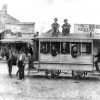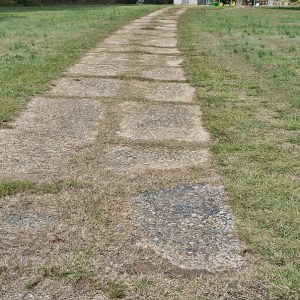calsfoundation@cals.org
Dollarway Road
The Dollarway Road represents Arkansas’s early twentieth-century efforts at road building for automobiles. Called the Dollarway Road because of its cost, it is important as an early example of the state’s short-lived system of road improvement districts. The Dollarway Road was also the longest continuous concrete pavement in the United States when complete, and it marked the first use of reinforced concrete for bridge construction in Arkansas.
Bicyclists started Arkansas’s Good Road Movement, which led to the establishment of the Good Roads League of the State of Arkansas in 1896. Upgrading road conditions and funding roads was a major concern. In 1907, the state legislature created road improvement districts, locally controlled groups that determined where roads would go and who would pay for them. The Dollarway was the responsibility of Road Improvement District No. 4.
Tradition holds that the road was called Dollarway because it cost one dollar per linear foot to construct. The final cost was closer to $1.36 per foot. In July 1913, the district chose Little Rock (Pulaski County) contractors Shelby and Bateman to construct the approximately twenty-three-mile road from Pine Bluff (Jefferson County) to the Jefferson County line. Property owners along the route of the road shared the cost of construction. Some property owners threatened to file an injunction, but the dispute was resolved when the per capita assessment turned out to be minor.
Concrete with a bituminous coating was the chosen construction material for the nine-foot-wide road. Four reinforced concrete bridges were part of the road design. The contractor considered concrete more economical and longer lasting than the packed stone paving known as “macadam” usually used for roads in Arkansas. Construction began in November 1913, and the road was finished in October 1914.
The road improvement district system worked for the Dollarway Road, but it was not an efficient system. The Arkansas Highway Commission, established in 1913, commented on the district system as having problems because of lack of supervision and training of personnel. In 1915, the commission had its own problems, having been accused of abusing its powers. Also in 1915, the state legislature passed the Alexander Road Law, allowing for individuals along a route to form their own road improvement district. Coupled with the Federal Aid Road Act of 1916, a law aimed at improving post roads, this resulted in about 500 road improvement districts being created in Arkansas by 1921. Another Federal Aid Road Act in 1921 attempted to alleviate this problem by requiring state highway departments to oversee all road construction. It was not until the Martineau Road Act of 1927 that the cost of road building in Arkansas shifted from property owners to road users.
The Dollarway Road is an example of experimentation in road construction material and methods. After initial concerns by residents along the route, property owners supported the construction of the road. Eventually, issues with local control and loss of federal support resulted in the demise of the system. Concrete proved to be a durable and inexpensive material for roads.
No markers now exist for the Dollarway Road, but some sections can still be seen, although modern-day Highway 365 covers most of the original road. A section of the road in Jefferson County, near Redfield, was listed on the National Register of Historic Places in 1974, and the nomination expanded in 1999. At that time, the road was visible and was called Reynolds Road.
For additional information:
McLaren, Christie H. “The Dollarway Road and Road Improvement Districts in Arkansas, 1913–1921.” In Looking Beyond the Highway: Dixie Roads and Culture, edited by Claudette Stager and Martha A. Carver. Knoxville: University of Tennessee Press, 2006.
“The Old Dollarway: It Was Narrow and Winding—But It Got You to Pine Bluff.” Arkansas Gazette. January 4, 1970, p. 6E.
Claudette Stager
Nashville, Tennessee

 Dollarway Road near Redfield
Dollarway Road near Redfield 



Comments
No comments on this entry yet.